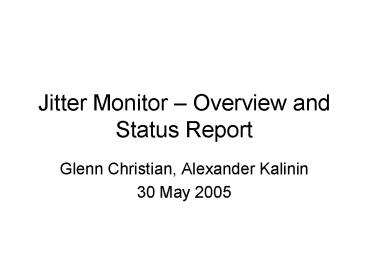Jitter Monitor - PowerPoint PPT Presentation
1 / 14
Title:
Jitter Monitor
Description:
Each processor will have a general delay value due to difference in cable ... Plan to take data parasitically to measure the 2-BPM resolution in this visit. ... – PowerPoint PPT presentation
Number of Views:28
Avg rating:3.0/5.0
Title: Jitter Monitor
1
Jitter Monitor Overview and Status Report
- Glenn Christian, Alexander Kalinin
- 30 May 2005
2
Contents
- Jitter Monitor Hardware Overview
- Measurement procedure
- March 2005 data taking
- Status of Analysis
- Resolution studies
- Plan for current run
3
Jitter Monitor Schematic
4
Jitter Monitor Hardware
5
Measurement Procedure
- Synchronisation
- Sum and Difference signals must be aligned to 10
ps - Dedicated data run for each processor at each
pick-up with large beam displacement to suppress
common-mode - Each processor will have a general delay value
due to difference in cable lengths and intrinsic
delay on board
6
Measurement Procedure 2
- Time align signals using synchronisation delay
- Calculate position as
- Calibrate position using correctors and known
displacements
7
Overview of March 2005 data taking
- Four jitter monitor processors used at BPMs
8,10,13 in ExtLine, and BPMs 26,27 in DR. - Data taken during three shifts
- Single-bunch mode synchronisation data for
8,13,26,27 and calibration for 26,27 - Multi-bunch synchronisation for bpm10,
calibration for 8,10,13 and resolution - Single-bunch mode 8,13 SB calibration. 26,27 to
8,13 correlation studies varying y, y, E. - Data taken with all quads off after QD6X.
8
Resolution
- Assuming the BPM thermal noise to be small the
resolution will be dominated by discretisation
noise of scopes. - 3 BPM method
- Use position measured in two BPMs to predict
position in third BPM. - Assuming noise of all three BPMs to be the same,
resolution is determined by std of residuals
divided by geometric factor.
9
Position in Extraction Line
10
Resolution
11
Angle-angle correlation
With all quads off between three BPMs the
trajectory should form straight line!
12
Resolution studies (cont)
- General increase in resolution as function of
bunch number along train lack of angle-angle
correlation suggest that residuals contain
contribution from jitter. - Can not be sure how the jitter propagates between
BPMs. Therefore 3 BPM method can not be used for
discretisation resolution.
13
Plan for parasitic work this run
- Plan to measure resolution by hooking up two
processors in series on one set of pick-ups.
Method eliminates bunch jitter from the
calculation leaving only dicretisation noise. - By making measurements at different scope scales
can also measure the resolution dependence on
number of discretes
14
Summary
- Jitter monitor analysis still in progress.
- Once present problems encountered with resolution
are solved, there is still lots of interesting
data to analyse from March. - Plan to take data parasitically to measure the
2-BPM resolution in this visit.































